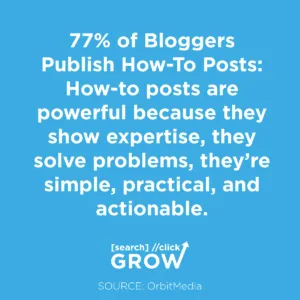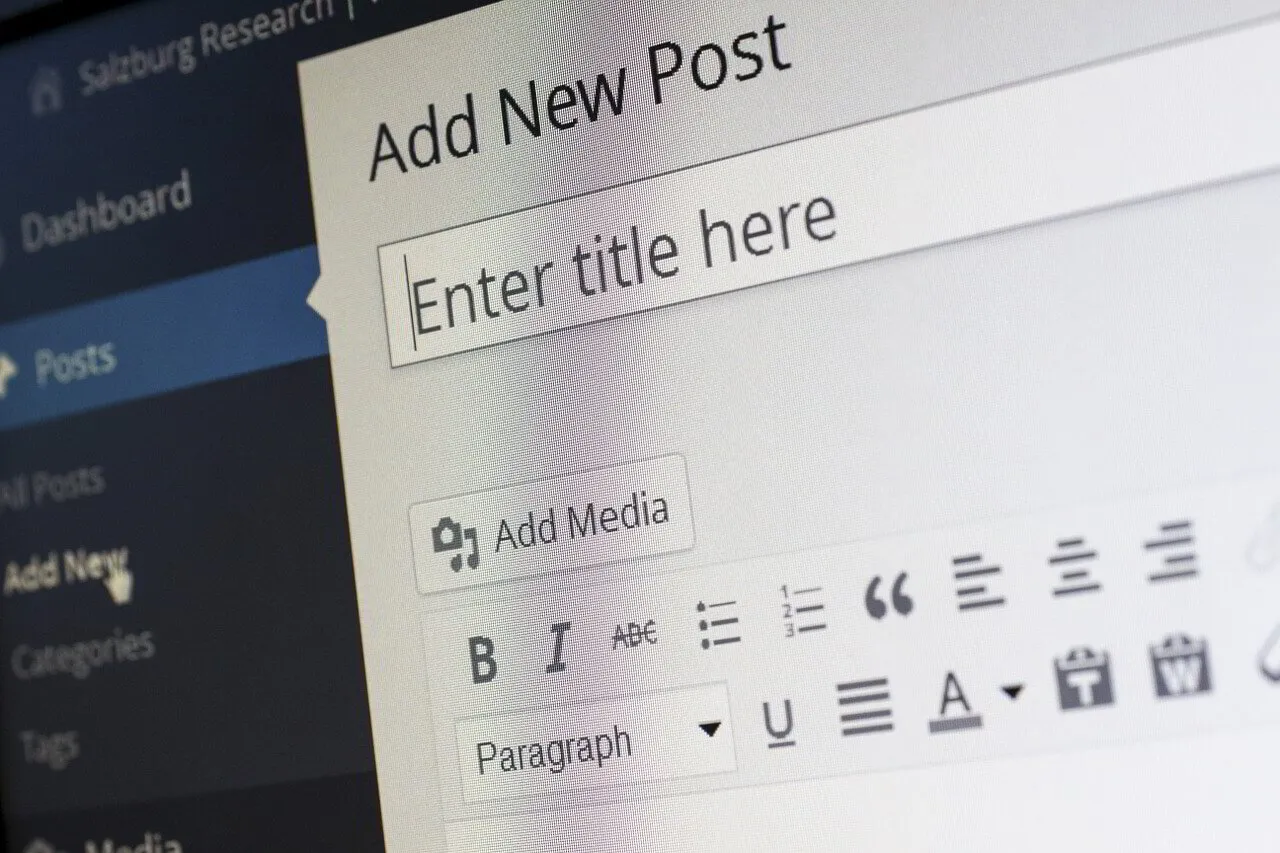What makes a blog post shareable? Is it the topic or readability that matters most?
For one thing, blog posts are never perfect. The other question you might be asking is how to outline a blog post?
You’ll find yourself constantly thinking of updates to add to old posts, whether for SEO reasons or discovering new information that would help visitors.
If you are passionate about what you write, then you’re already ahead of the 45 billion web pages that Google blocks every year for poor content.
The most common problems of bad blogs include unreadable formatting, inconsistent flow, and the plague of keyword spam.
All of which can be cured with a step-by-step guide on how to outline a blog post.
Here are the steps:
- Determine what kind of post you want to write
- Write down a working title
- Organize your content into sections (outline your blog post)
- Keep revising and organizing your outline
- Add links and sources
- Spice up your content
Step-by-Step Guide for How to Outline a Blog Post
So, how do you outline a blog post?
From beginning to end, the number one rule is that your blog post must make sense for the reader.
Before heading into this outline, here are a few quick tips to think about:
- Who is this post for?
- What challenges does this topic answer for your audience?
- What’s the key message of your post?
- Is your post a standalone topic or part of a series?
- What’s your word count goal?
- What sources and research do you need to support your article?
Always know your reader’s search intent. Were they looking for a guide, comparison, list, or answer? Just knowing what kind of information your visitors want can guide you through any writer’s block.
1. Determine What Kind of Post You Want to Write
First things first: what type of blog are you writing?
Here are some blog examples to consider:
- Tutorial how-to: Show your readers how to do something
- What’s trending: Talk about the latest news and information in your niche
- Personal story: Share a unique experience within the business
- Review or compare products: What are the most valuable products in your niche
- List: What are the top items or resources relevant to your blog topic or keyword
- Interview: What does an expert have to say about this topic?
- Inspire: Talk about something that will help your readers take action
- Controversy: Is something going on in your industry? Give your insider take
- Entertainment: Write about something fun and innovative that your audience will enjoy
Note: We created a downloadable workbook called The 13 Week Content Planner that helps you plan out a full 13 weeks or 1 quarter’s worth of content for your business.
Style and Tone
Next, what’s the style of your post? This goes along with your brand voice and audience personas.
You should know just the right tone and emotion you want to elicit with your content.
Here are a few ways to consider the style of your post:
- Informational
- Insider take/insightful
- Whimsical/inventive
- Motivational
- Data-driven/scholarly
- Personal
- Authoritative
Note: You can use a tool like Grammarly or SEMrush Writing Assistant to see how your tone comes across to readers. It can even tell you when your writing is a little dull.
What and Why of the Post
The next thing you’ll tackle is the what and why of the post.
The best way to do this is to just open up a Google Docs or even get out a pen and paper, then write down everything you want the audience to learn from the blog post.
You can write down anything relevant to the working title, but keep the audience’s search intent in mind.
In this step, you’re not thinking about formatting or organizing, but rather, just ideas.
In about 10 minutes, you should have a list of questions and answers, trends, related events, or even celebrity connections, or any other ideas that pertain to your topic.
Taking out the example of “gifts for mom”, we’d probably create a list of ideas like this:
- What gifts for mom are trending
- Best gifts for moms birthdays
- How to pick a gift for your mom
- Tips for picking out gifts for moms at different ages
- How to know what to get your mom for [holiday]
- Budgets for mom’s gifts
- What have celebrities bought their moms
- Gifts for tech moms
We could go on forever, and so can you! It’s best to spend as much time as possible just thinking about what you want the reader to know in this post.
Even if it’s a word dump on the page, these ideas will come in handy as we build out your blog outline.
2. Write Down a Working Title
The beginning of every outline starts the same.
What’s the working title of this blog?
If you think of it as a project, how would you reference it when explaining it to someone else?
Your title should always include the keyword you want to rank for. This is where you determine if it’s a “how-to” article or a curated list of helpful tools for the reader.
The best working titles are a little more specific than the final headline will be. It should inspire you to write in great detail about the topic, too.
To begin, just brainstorm around a keyword. For example, “gifts for mom” queries may be served well by titles like “Top 10 Gifts for Mom on Valentine’s Day” or “16 Birthday Gifts for Mom”.
Brainstorming is a great way to start off any outline, so write down as many titles as you like that fit the topic and answer the question, even if it doesn’t sound catchy at first.
Just remember that you’re only brainstorming and outlining right now, not creating perfect prose.
3. Organize Your Content Into Sections (Outline Your Blog post)
This next step organizes your content into a theme with different sections. You’ll take your jumble of ideas from the previous step and start looking for section headers that can quickly group your ideas together. In each section, list a few of the takeaways.
We think it’s best to choose an easily accessible, collaborative document like Google Docs for blog outlines, especially if you want to access it from anywhere or share it with a team.
For example, our outline for “gifts for mom” might look like this:
I. Intro
H1: X Gifts for Moms Who Love Astronomy
- Set expectations
- Outline the problem or issue
- What are the risks of not learning this
- What is our promise to you in this article
- Transition into the topic
II. Body
H2: Gift Ideas for Moms Who Love the Moon
- Moon phase blanket
- Artwork and prints featuring the moon
- Swarovski crescent moon necklace
- Household items like constellation mugs or nebula ceiling lights
H2: Trips for Moms Who Love Space
- How much to visit NASA
- Best places to watch the stars
- Major comets or other astronomy events and where to go to see them
H2: Gifts for Geeky Space Moms
- Best telescopes
- Watches for astronomy lovers
- Name a star after your mom
H2: 4. Guide to Gifts for Your Mom
- How to know what to get your mom
- Special ways of wrapping gifts
- Picking a card for your astronomy mom
III. Recap
H2: Over to You and Next Steps
- Quick wrap-up or any forgotten questions to answer
- Ask your audience a question about the best gifts they’ve given their moms
- Add a CTA or link to other related to a blog post
You can keep adding sections and takeaways from each. Some sections may have way more content than others in your outline, which means you’ll probably have to break out some information or look at how to be more specific.
However, this is just your first draft.
You’ll continue to add to your outline and streamline the ideas until you like the flow enough, which is when you’re ready to write your blog.
4. Keep Revising and Organizing Your Outline
Now that you have a basic outline, you can keep building on your ideas. In this step, you should be streamlining and removing things that don’t fit the flow. If you have too many ideas in one section, just go back to audience intent.
If it’s absolutely necessary information, then you may want to consider breaking out a new section.
You’ll tighten up your outline as much as possible in this step.
- Make sure it’s relevant to the search intent and keyword
- Read through ideas to ensure good flow
- Sub-topics should make sense
- Ensure readers learn something valuable
Some ideas get cut because they just don’t make the most sense or maybe we’ve discovered a different theme that answers the query better.
For example, our original outline tried to tackle all kinds of space gifts for moms, but maybe we could include a section on budget-friendly gifts for space-loving moms and change the guide for how to pick space gifts, instead of generalized gifting tips.
Once you have your sub-topics in place, you can keep adding bullets to flesh out the section, focusing on what readers will take away from each bullet.
You should have a comprehensive list of topics and sub-topics to fill in your blog now.
With more details in your outline, your post will be easier and faster to write.
5. Save Time and Add Links/Sources
After going through your outline and solidifying the content, you can also add data, links, and sources to enhance your content and support any statistics that you share.
You can add these as bullets in each section under the claim or statistics that you’ll be writing about.
When you go to write your post, you’ll already have all of your links and sources paired with each sub-topic.
In addition, some go as far as including:
- Quotes
- News events
- Other interesting tidbits that will make your content more authoritative and entertaining for readers
For those creating a list with products, you may want to get into an affiliate marketing program, such as Amazon Associates or ShareASale to get money from the traffic you send by mentioning these products.
6. Spice Up Your Content Just a Pinch
Now that your outline is detailed, sourced, and organized, you can look for areas to spice up or make more entertaining.
Perhaps there’s a special anecdote you can add or a reference to a movie that relates to your audience's interests.
Basically, how can you make this post more unique and endearing to your audience?
Add a Compelling Video
You may want to find a couple of videos or a truly spectacular video example that relates to your blog topic. There’s something about videos that draw the eye and make people more interested in what you’re talking about.
Sometimes in lieu of how-to or demonstration content, you can also share entertaining clips that shed light on the problem or empathize with the reader.
Include an Interview
Do you know an expert in the field? Question and answers work well in any blog topic because it answers multiple questions that readers might have and provides strategic SEO content.
You may get even more ideas to add to your post just by talking to someone about your topic and asking a few questions about things your readers want to know.
Start a Twitter Conversation
People often share content because you started sharing first. If you find experts and influencers on Twitter who talk about your topic, you can always share their tweets on your blog.
Not only does this show you’re clued into the latest trends, but it may provide traffic to influencers and even brands on social media. This could lead to a partnership and more viral opportunities for your content down the road.
Over to You and Next Steps
Once you’ve written a tremendous blog outline, it’s time to write your blog post. Now that you have all the meat and potatoes, the writing should flow naturally.
Creating an outline should always happen before you start writing your blog post. Not only will it help you write your content, but more importantly, it will help your readers stay engaged.
If you need help writing your blog post you can head over to our resources page. We provide a variety of free and paid tools and content that you can use to help you grow your business.






